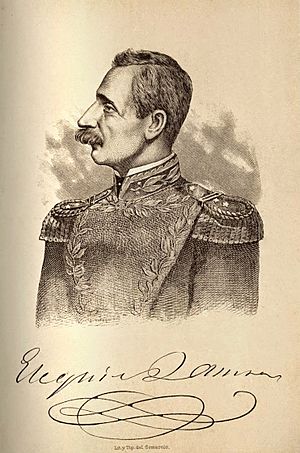Ezequiel Zamora facts for kids
Quick facts for kids
Ezequiel Zamora
|
|
|---|---|
 |
|
| Born | 1 February 1817 Cúa, C. G. de Venezuela, Spanish Empire |
| Died | 10 January 1860 (aged 42) San Carlos, State of Venezuela |
| Years of service | 1846 - 1860 |
| Rank | General en Jefe |
| Commands held | Jefe de Operaciones de Occidente (1859 -1860) |
| Battles/wars | 1846 peasant insurrection Federal War |
Ezequiel Zamora (born February 1, 1817 – died January 10, 1860) was a brave Venezuelan soldier. He was a key leader of the Federalists. This group fought in the Federal War (Guerra Federal) from 1859 to 1863. Zamora wanted to bring more fairness to the people of Venezuela.
Contents
Who Was Ezequiel Zamora?
Ezequiel Zamora was born in a town called Cúa in Miranda State, Venezuela. His parents, Alejandro Zamora and Paula Correa, were simple landowners. They were not rich, but they owned their land.
Early Life and Education
When he was a young boy, Zamora received a basic education. This was common for children in rural areas back then. Venezuela was still recovering from its fight for independence from Spain.
Later, Zamora moved to Caracas, the capital city. He continued his primary school studies there. This was the only formal schooling he ever had. However, he learned a lot more outside of school. His brother-in-law, John Caspers, helped him learn about politics. Zamora was inspired by revolutionary ideas happening in Europe. He also became friends with a lawyer named José Manuel García. From him, Zamora learned about modern ideas and old Roman laws. He quickly became a strong supporter of "equality for all." He believed these ideas needed to be put into practice in Venezuela.
Becoming a Leader
In 1849, Zamora joined the Liberal Party. He tried to become an "elector" for the canton of Villa de Cura. But other groups, called conservatives, tried to stop him. They used unfair methods to prevent his nomination. This showed how much tension there was between the Liberals and Conservatives across the country.
Peasants in the central region started to rise up. Zamora quickly called for a "war with the Goths." This was a nickname for the conservative landowners. He wanted to help the poor people.
A Fight for Fairness
On September 7, 1846, Zamora began his fight in the town of Guambra. People started calling him "General of the Sovereign People." He used important slogans like "land and free men" and "respect the peasant." He also called for the "disappearance of the Goths."
Zamora won some battles, but he was later defeated. He was captured at the Battle of the Laguna de Piedra. A court sentenced him to death. However, President José Tadeo Monagas changed his sentence to 10 years in prison. Zamora escaped from prison and worked as a laborer on a farm. The next year, he was officially pardoned.
Sometime later, he joined the liberal army again. This army fought against the powerful landowners. In 1849, Zamora even captured a famous general, José Antonio Páez. Zamora was promoted to colonel in 1851. But the landowners eventually gained power again. Zamora had to go into exile in Curaçao. In 1858, a group called the Patriotic Meeting formed in Curaçao. They started a rebellion against General Juan Crisóstomo Falcón, who was Zamora's brother-in-law.
The Federal War
On February 23, 1859, Zamora returned to Venezuela. He landed in La Vela de Coro as part of the Federal War. He was named the Chief Operator of the West. He declared Coro a federal state on February 25, 1859. He also helped organize a temporary government for Venezuela.
On March 23, he won a battle at El Palito. From there, he planned to move towards the western plains. He took the city of San Felipe on March 28. He then reorganized that province as a federal area, naming it Yaracuy.
Leading the Charge
On December 10, 1859, a very important battle happened. It was called the Battle of Santa Inés. Zamora led his army to victory against the Centralist army. This battle was a major turning point in the Federal War. It showed Zamora's amazing skills as a military leader.
After Santa Inés, Zamora moved his army towards the center of the country. He had about 3,000 foot soldiers and 300 cavalry (soldiers on horseback). He passed through Barinas and Portuguesa. Before reaching Caracas, he decided to attack the city of San Carlos. About 700 men defended the city's main square.
Zamora's Legacy
On January 10, 1860, during the fight to take San Carlos, Zamora was shot in the head. This caused his death. How he died is still a bit of a mystery. Some people believe the shot might have come from his own side. His sudden death changed the course of the war for the Federalists. They lost a great leader.
Many people consider Ezequiel Zamora to be one of the most important popular leaders in 19th-century Venezuela. His remains are now in the National Pantheon in Caracas. This is a special place where important Venezuelan heroes are buried.
In 2001, a new program was started under President Hugo Chávez. It was called Mission Zamora. This program aimed to change how land was owned and used. It was named after Ezequiel Zamora to honor his ideas about land fairness.
Ezequiel Zamora's life was also shown in a movie. Alexander Solórzano played him in the 2009 film Zamora: tierra y hombres libres.
Images for kids
-
Statue of Ezequiel Zamora, Railway Station, Cúa
See also
 In Spanish: Ezequiel Zamora para niños
In Spanish: Ezequiel Zamora para niños


